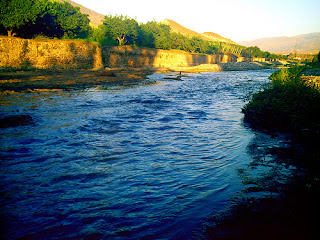TUNNELS:
A tunnel is an underground
passageway, completely enclosed except for openings for ingress and egress,
commonly at each end.
A tunnel may be for foot or
vehicular road traffic, for rail traffic, or for a canal. Some tunnels are
aqueducts to supply water for consumption or for hydroelectric stations or are
sewers. Other uses include routing power or telecommunication cables, some are
to permit wildlife such as European badgers to cross highways. Secret tunnels
have given entrance to or escape from an area, such as the Cu Chi Tunnels or
the smuggling tunnels in the Gaza Strip which connect it to Egypt. Some tunnels
are not for transport at all but rather, are fortifications, for example
Mittelwerk and Cheyenne Mountain.
In the United Kingdom, a
pedestrian tunnel or other underpass beneath a road is called an underpass
subway. In the United States that term now means an underground rapid transit
system.
The central part of a rapid
transit network is usually built in tunnels. Rail station platforms may be
connected by pedestrian tunnels or by foot bridges.
CONSTRUCTION:
Tunnels are dug in types of
materials varying from soft clay to hard rock. The method of tunnel
construction depends on such factors as the ground conditions, the ground water
conditions, the length and diameter of the tunnel drive, the depth of the
tunnel, the logistics of supporting the tunnel excavation, the final use and
shape of the tunnel and appropriate risk management.
There are three basic types
of tunnel construction in common use:
Cut and cover tunnels,
constructed in a shallow trench and then covered over.
Bored tunnels, constructed
in situ, without removing the ground above. They are usually of circular or
horseshoe cross-section.
Immersed tube tunnels, sunk
into a body of water and sit on, or are buried just under.
VARIANT TUNNEL TYPES
DOUBLE-DECK
TUNNEL
Some tunnels are
double-deck, for example the two major segments of the San Francisco – Oakland
Bay Bridge (completed in 1936) are linked by a double-deck tunnel, the largest
diameter bore tunnel in the world. At construction this was a combination
bidirectional rail and truck pathway on the lower deck with automobiles above,
now converted to one-way road vehicle traffic on each deck.
ARTIFICIAL
TUNNELS:
Over-bridges can sometimes
be built by covering a road or river or railway with brick or steel arches, and
then leveling the surface with earth. In railway parlance, a surface-level
track which has been built or covered over is normally called a covered way.
Snow sheds are a kind of
artificial tunnel built to protect a railway from avalanches of snow. Similarly
the Stanwell Park, New South Wales steel tunnel, on the South Coast railway
line, protects the line from rockfalls.
HAZARDS:
Owing to the enclosed space
of a tunnel, fires can have very serious effects on users. The main dangers are
gas and smoke production, with low concentrations of carbon monoxide being
highly toxic. Fires killed 11 people in the Gotthard tunnel fire of 2001 for
example, all of the victims succumbing to smoke and gas inhalation.
THE LONGEST TUNNELS
· The Delaware
Aqueduct in New York USA is the longest tunnel, of any type, in the world at
137 km (85 mi). It is drilled through solid rock.
· The Gotthard
Base Tunnel will be the longest rail tunnel in the world at 57 km (35 mi). It
will be totally completed in 2017.
· The Seikan
Tunnel in Japan is the longest undersea rail tunnel in the world at 53.9 km
(33.5 mi), of which 23.3 km (14.5 mi) is under the sea.
· The Channel
Tunnel between France and the United Kingdom under the English Channel is the
second-longest, with a total length of 50 km (31 mi), of which 39 km (24 mi) is
under the sea.
· The Lötschberg
Base Tunnel opened in June 2007 in Switzerland was the longest land rail
tunnel, with a total of 34.5 km (21.4 mi).
· The Lærdal
Tunnel in Norway from Lærdal to Aurland is the world's longest road tunnel,
intended for cars and similar vehicles, at 24.5 km (15.2 mi).
· The
Zhongnanshan Tunnel in People's Republic of China opened in January 2007 is the
world's second longest highway tunnel and the longest road tunnel in Asia, at
18 km (11 mi).
·
The longest canal tunnel is the Rove Tunnel in
France, over 7.12 km (4.42 mi) long.

























